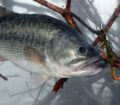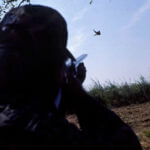Editor’s Note: For years, the secret was kept primarily in the Southeast. Those good ole boys living along the Appalachian chain of mountains, who were accustomed to catching live bait and using that bait to take bass, rarely shared their secret. Most folks knew that crayfish, night crawlers and minnows would catch bass, and that occasionally a bigmouth could be caught on a frog or a mouse. But the men from the hills discovered that the best bait for bucketmouths were amphibians known as spring lizards and waterdogs – two different kinds of salamanders. The spring lizard and the larvae of the tiger salamander, which are called waterdogs, are best for bass. Cold-blooded, salamanders become more active when temperatures are cooler – just the opposite of most live bait. In an aquarium test, bass ignored minnows, frogs and worms to grab the long-lasting and active waterdogs and spring lizards.
 Another noted outdoorsman who came to realize the potential of salamanders for bassing was the late Carl Lowrance of Tulsa, Oklahoma, who founded Lowrance Electronics. Mr. Lowrance had done plenty of bass research, and with his two sons developed the now famous, Lowrance depth finders. But Carl’s primary concern was not becoming a fishing-tackle manufacturer. He just liked to catch fish. And one day years ago, while fishing in Tennessee, someone shared a bucket of spring lizards with him. Since then Lowrance’s fishing life drastically changed as he lugged chests full of waterdogs literally around the world for fishing. At one time, Carl Lowrance devoted himself to breeding, cross breeding and growing waterdogs.
Another noted outdoorsman who came to realize the potential of salamanders for bassing was the late Carl Lowrance of Tulsa, Oklahoma, who founded Lowrance Electronics. Mr. Lowrance had done plenty of bass research, and with his two sons developed the now famous, Lowrance depth finders. But Carl’s primary concern was not becoming a fishing-tackle manufacturer. He just liked to catch fish. And one day years ago, while fishing in Tennessee, someone shared a bucket of spring lizards with him. Since then Lowrance’s fishing life drastically changed as he lugged chests full of waterdogs literally around the world for fishing. At one time, Carl Lowrance devoted himself to breeding, cross breeding and growing waterdogs.
Lowrance once told me, “Waterdogs are the best fishing baits in America today, because bass will hit them when they won’t take anything else. The bass’s instincts tell him that a waterdog is much like dessert. No matter how much room you have left in your stomach, you still have just a little more room to take a bite. The 1-1/2 inch to 4-inch waterdogs are absolutely the best bait that I ever have used for smallmouth bass. And the bigger waterdogs are excellent for larger, trophy largemouth bass.”
Carl Lowrance explains that there are about three different methods of fishing the waterdog. “But I prefer to use a No. 1/0 or a No. 2/0 hook and no sinker with 6-pound-test line on an ultralight rod and reel. You can cast the waterdog into an area and work it slowly back to the boat. If you don’t get a bite, you’ll know there are no bass in the area. If you are fishing deeper water, use a split shot about 18 inches up the line. Although you can angle the salamander in heavy cover, I recommend using 20-pound-test line if you are fishing in heavy brush.”
 When to Set the Hook on Salamanders:
When to Set the Hook on Salamanders:
Most newcomers to salamander fishing encounter the same problem- when to set the hook on the salamander. Anglers agree that under various circumstances a different amount of time is required for the hook set.
1) Bedding bass – Most of the time a bedding bass won’t eat the salamander, but she will move it off her bed. When this occurs, all the fisherman will feel is a very-light tick on the line. Sometimes the bass already has expelled the spring lizard by the time an angler sees the line move. So, on bedding bass, the best rule of thumb is to hit the fish the minute you see the line move.
2) Aggressive Striking Bass – When a bass hits the salamander, and your line jumps and feeds off quickly, hit the fish instantly. According to Carl Lowrance, “This generally means there are a lot of bass in the area. The fish that took your lure wanted to gobble up the bait quickly and get the lizard out of the region where there was competition for the waterdog from other bass. Once you land that fish, cast the waterdog right back into the same spot, if the waterdog is still alive. The chances are extremely good that you will catch another bass.”
3) Slow-Hitting Bass – If a bass picks up the waterdog and moves off slowly with it, then the angler should feed the fish some line. “In most cases, the bass will pick the salamander up by the tail and leisurely swim off with it until the bass decides to swallow the dog,” Lowrance says. “So, you’ve got to give the fish enough line and enough time to allow it to get the waterdog in its mouth and set the hook. In some instances I have let bass run 30-40 feet before I’ve set the hook.”
 Of course one drawback to fishing the waterdog has been the difficulty of seining and netting them. Always look for pond areas with few weeds because dense vegetation makes seining hard. Also concentrate on temporary ponds that dry up by mid-summer. This type of pond will lack predatory fish that will quickly eat up the larval waterdogs. Commercial breeders of waterdogs are few, but you may find local breeders in your bait shop.
Of course one drawback to fishing the waterdog has been the difficulty of seining and netting them. Always look for pond areas with few weeds because dense vegetation makes seining hard. Also concentrate on temporary ponds that dry up by mid-summer. This type of pond will lack predatory fish that will quickly eat up the larval waterdogs. Commercial breeders of waterdogs are few, but you may find local breeders in your bait shop.
To learn more about bass fishing, check out John E. Phillips’ eBooks, print books and Audible books at https://johninthewild.com/books#bass.










